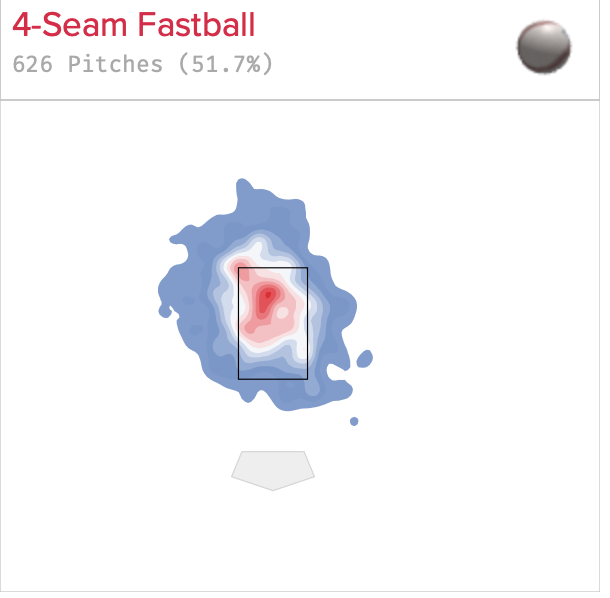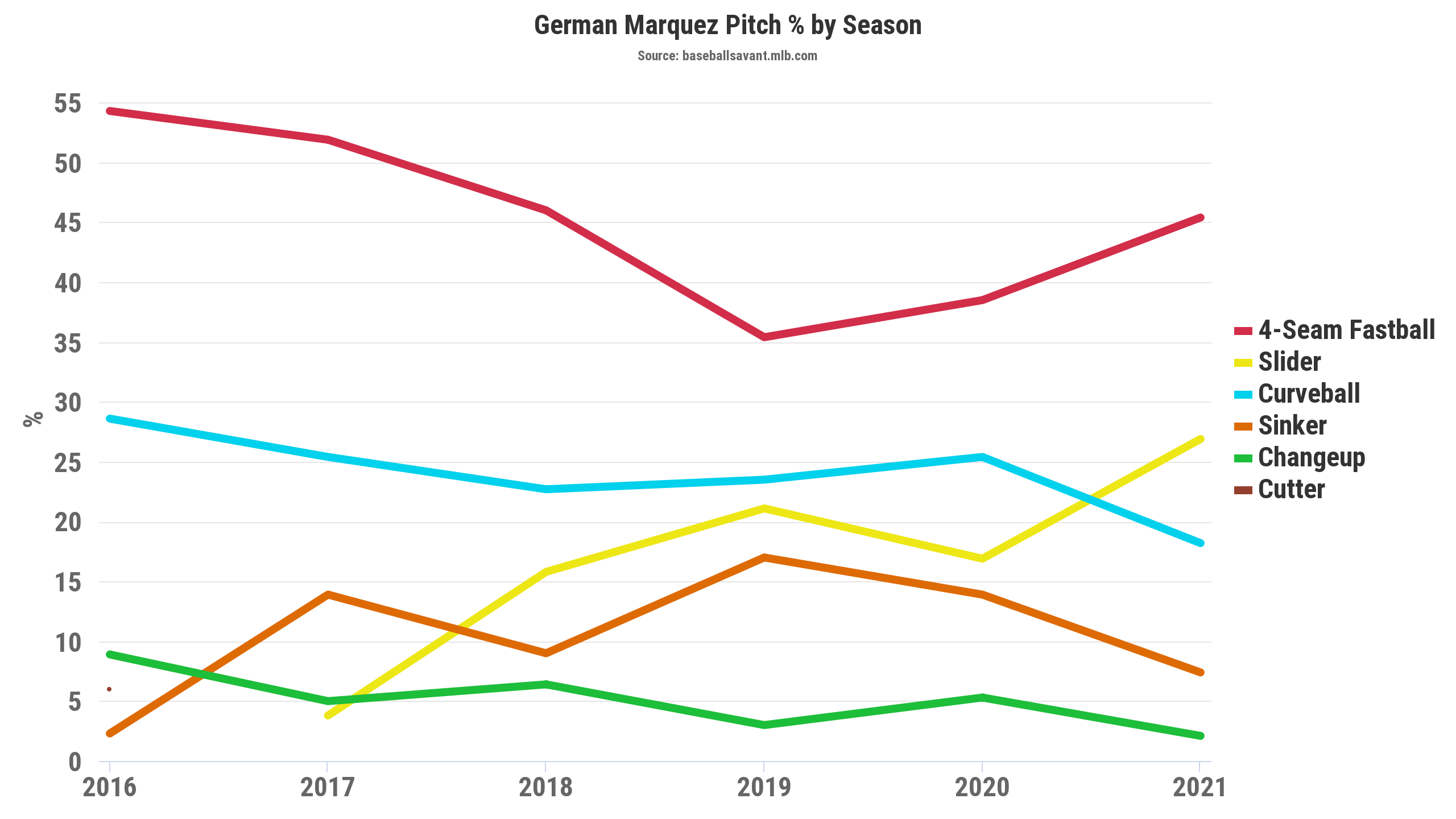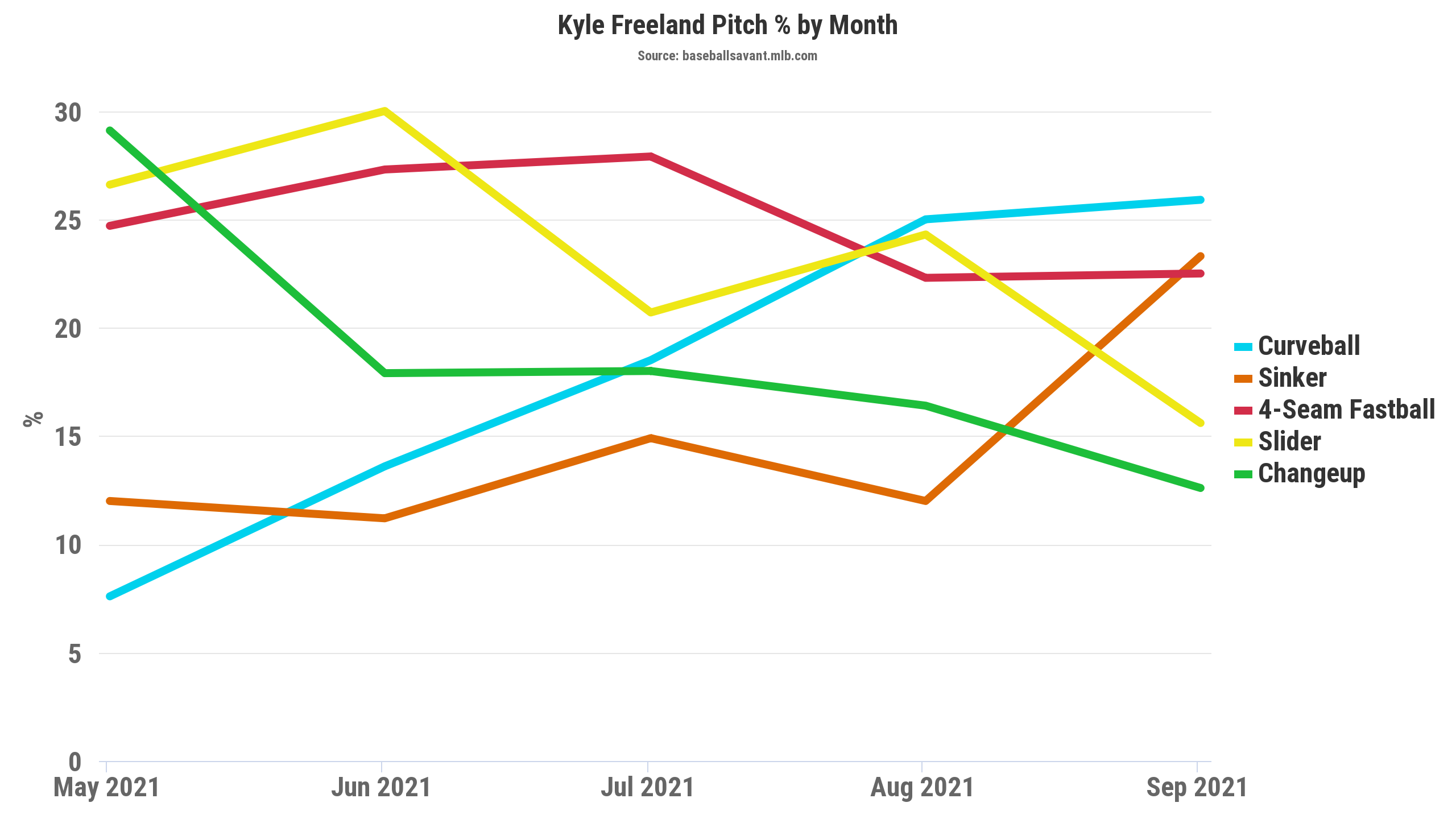Some may think of pitching as a skill, but I see it as more of a science. You can have the greatest pitching arsenal in the world, but if you aren’t utilizing it correctly, your potential will be left untapped. As they say, baseball isn’t easy; if every pitcher was able to utilize their pitches to perfection, what would be the need for a pitching coach and a player development staff?
We’ve already seen some clear trends with pitch usage in recent years. Check out the percentage of fastballs being thrown in the MLB, starting in 2015:
- 2015: 57.7%
- 2016: 56.7%
- 2017: 55.6%
- 2018: 54.9%
- 2019: 52.5%
- 2020: 50.5%
- 2021: 51.1%
A consistent decrease in fastball usage has become a principle value in the modern-day pitching approach. Why is this the case?. Let’s look at offensive success against every pitch type since 2015:
Intuitively, it all makes sense; throw the pitches that lead to better results more often! Yet, it is not this easy. Part of the reason offspeed pitches are as successful as they are on a per-pitch basis is that they aren’t overexposed. In the end, you need to remain unpredictable while throwing your best pitches, which is the difficulty of it all. However, one thing is clear: significant fastball reliance could come back to bite you.
At the end of the day, though, the best pitching approach is one that is individualized to the pitcher at hand. No two pitchers are exactly the same, so it’s the job of the pitcher, pitching coach, player development staff, and others to try to find a way to optimize the pitcher’s arsenal to as close to perfection as they can. A way to do so? Finding out which pitchers are over and underutilized.
That is what we will be focusing on in today’s piece. By looking at which pitchers are utilized too much and not enough, we can get an idea of which pitchers have the most untapped potential that can be unlocked with a pitch-mix change. This can lead to extra upside in fantasy baseball drafts should they make these changes, meaning you might want to have those players on your roster next year. Who are this year’s diamonds in the rough? Let us start our quest!
For the complete data, click here.
Underutilized Fastballs
To discover which pitches are over and underutilized, we have to put them on the same scale, for comparison purposes. Thus, for this study, we will be comparing the percentile usage of each pitch with the percentile whiff rate and xwOBA allowed. In other words, we’re comparing the effectiveness of the pitch to the amount it is used. However, it is important to remember that the percentile scales are adjusted for each pitch. The average whiff rate of a breaking ball is naturally going to be higher than the whiff rate of a fastball, so that needs to be taken into account. Or else, breaking balls would dominate the list as the most underutilized pitches.
With that addressed, let us take a look at the most underutilized fastballs:
Yu Darvish has become a frontline starter throwing an array of pitches, but it might be time for him to lean on his fastball more. In 2021, it had the highest whiff rate (34.3%) of any of his pitches and has allowed an xwOBA under .250 in back-to-back seasons. His cutter, on the other hand, allowed a .427 wOBA last year and has generally not been a super effective offering for him.
Darvish’s fastball features 2.8 inches of extra vertical movement than average for a fastball of similar characteristics. That’s the type of pitch that can be peppered at the top of the zone as a lead pitch. However, with his cutter and slider being his top two featured pitches, the Padres starter has opted for more of a horizontal approach. On the bright side, his 32.1% fastball usage in September is perhaps a sign of optimism for the future.
Then, there is Chris Bassitt, who finds himself in a similar dilemma. Just take a look at his career splits between his fastball and sinker:
- Fastball: .249 wOBA allowed, 19.6% usage
- Sinker: .343 wOBA allowed, 38.2% usage
That doesn’t seem optimal. Bassitt clearly has a gift with his fastball, and it’s time for him to use it. Considering it has below-average vertical movement, it may seem odd that it has had the success that it has had. Yet, one variable doesn’t tell the whole story. Due to Bassitt’s low release height (5.54 inches), it works effectively at the top of the zone:
Chris Bassitt, 93mph Fastball and 71mph Curveball, Overlay. pic.twitter.com/OhPcwe5HNi
— Rob Friedman (@PitchingNinja) September 23, 2021
As you can see, the pitch has a very flat approach angle and complements his curveball perfectly. With over 20 MPH of separation between the two, it’d be great to see him lower the usage of his sinker and go with more of a vertical approach moving forward. He already had a career-high 25% strikeout rate last year, and I think that he’s capable of more.
Over-utilized Fastballs
As a former top prospect with a career 28.6% strikeout rate and 28.1% whiff rate, Triston McKenzie has an extensive amount of potential. Yet, it hasn’t come to fruition quite yet. One solution? Throwing his fastball less. In 2021, the 24-year-old threw his fastball 61.6% of the time, but with his slider and curveball each inducing whiffs over 44% of swings against it, it would make sense for there to be a more balanced approach. For context, with slightly lower fastball (53.3%) usage in 2020, McKenzie posted a 33.1% strikeout rate in 33.1 innings. With a more balanced approach, I think McKenzie could take his abilities to another level next year and be a massive steal in fantasy drafts.
In a similar boat to McKenzie is Josiah Gray. The 24-year-old struggled with a 5.48 ERA, and his issues with his fastball have a lot to do with it. In fact, the splits between his fastball and offspeed pitches are drastic:
- Fastball: .409 xwOBA allowed, 17.9% whiff
- Curveball: .209 xwOBA allowed, 47.8% whiff
- Slider: .211 xwOBA allowed, 45% whiff
Gray’s fastball features plus vertical movement and horizontal movement, but his command of the pitch leaves a lot to be desired:

With two distinct breaking balls, Gray doesn’t need to throw his ineffective fastball over 50% of the time. With a 30.2% whiff rate, Gray already has the ability to miss bats. Now, though, it’s about sequencing his pitches in a way that can limit hard contact.
Underutilized Sinkers
In the modern game, sinkers aren’t often a pitch that is promoted as one to feature, but there are still some pitchers who could afford to throw their sinker more:
In 2020, Aaron Nola increased his sinker usage to 20.3% and was extremely successful (3.25 SIERA) with that approach. In 2021, however, he went back to a 4-seam centric approach, throwing his sinker 13.9% of the time. Interestingly, Nola induced ground balls at a 9% lower rate than normal, while his fastball (.360 xwOBA) was hit hard. The 28-year-old, whose sinker features 2.1 extra inches of horizontal movement and came into the league as a sinker-baller, utilizes his sinker on the corner to induce called strikes and ground balls. Considering he posted a 3.26 SIERA and 31.1% called-strike-whiff rate, Nola doesn’t necessarily need to make a pitch-mix change. That being said, getting back to inducing ground balls at a 50% rate wouldn’t hurt.
Over-utilized Sinkers
With the most over-utilized sinker among starting pitchers, 2021 wasn’t an ideal year for Zach Davies, who posted a 5.78 ERA last year. Considering Davies’ 2020 success came with balanced usage between his sinker and changeup, as opposed to 2021, where he threw his sinker 52.5% of the time, perhaps there’s a pitch mix change to be made. Sadly, though, it doesn’t look there is much potential to un-tap here. Interestingly, among pitchers who throw both a sinker and four-seamer, not a lot of pitchers show up for having over-utilized sinkers. This is a positive sign; pitchers are balancing the usage between their fastball and sinkers optimally, leading to strong results.
Underutilized Cutters
Cutters aren’t super common pitches but can be a very effective part of a pitcher’s arsenal. These pitchers would certainly benefit from throwing their cutter more often:
If you take away Luis Garcia’s fastball, you have arguably one of the best pitching arsenals in the MLB. None of the other four pitches he throws have a wOBA allowed over .280, and all have whiff rates over 36%. However, the 25-year-old’s cutter stands out as the best of the bunch. It can be a clear partial substitute for a fastball that allowed a .388 xwOBA last season; it allowed a .231 xwOBA and induced a whiff on 42% of swings against it. That’s right; a 42% whiff rate on a cutter!
Luis Garcia, Nasty 88mph Cutter…and Sword. ⚔️ pic.twitter.com/Wt6hzlC1Eo
— Rob Friedman (@PitchingNinja) October 30, 2021
Then, there is Marcus Stroman, who also has a deep arsenal, in addition to a terrific cutter. The 26.8% whiff rate on the pitch ranked in the 63rd percentile among cutters, while it was a clear put-away pitch for him. In his slider, split-finger, and cutter, Stroman has three pitches he can use to get strikeouts. He could throw his cutter (15.4%) a little more in favor of his sinker (42.1%), but he’s using the cutter perfectly as a whiff pitch as is. There’s a reason he just signed a three-year, $71 million contract with the Cubs.
Over-utilized Cutters
When you have three pitches with a whiff rate over 30%, including your fastball, you’d expect to have a strikeout rate higher than 24.5%. Yet, that is not the case for Yusei Kikuchi. Kikuchi’s cutter only produced a 19.5% whiff rate, while it also allowed a .424 xwOBA. Nevertheless, he threw it nearly as much (35%) as his fastball (35.6%). When over 70% of your pitches allow an xwOBA over .360, that’s a problem. Hopefully, we see Kikuchi incorporate more sliders and changeups next year.
Working in shorter stints, it would be nice to see Michael Wacha embrace his changeup (29.4%) more, but he continues to lean on an ineffective cutter (24.8%) that has allowed a wOBA over .365 in back-to-back seasons. Hopefully, now that he’s signed with the Red Sox, he’s in a spot where he can make that adjustment.
Underutilized Changeups/Splitters
It’s common logic for a starting pitcher to have an effective third pitch, which is generally what a changeup or splitter is. However, for these pitchers, their changeup/splitter can be much more than a complementary offering.
Shohei Ohtani is a freak talent, but could you imagine his potential as a pitcher if he threw what arguably is one of the best pitches in baseball more than 18.3% of the time. While his fastball and cutter are ineffective, his splitter allowed an xwOBA of .141 and induced a whiff on 48.5% of swings against it. That is absolutely absurd. After posting a 3.18 ERA last year with a 29.9% strikeout rate, Ohtani is an excellent pitcher as is. However, the upside of him throwing his splitter more is enormous.
Speaking of throwing your splitter more and ditching your ineffective pitches, that’s exactly what Frankie Montas did last year, and it worked!
If we were to rank Montas’ pitches, it would probably work like this
- Splitter (.164 wOBA, 51.4% whiff)
- Fastball (.292 wOBA, 24.6% whiff)
- Sinker (.370 wOBA, 17.2% whiff)
- Slider (.317 wOBA, 15.2% whiff)
Thus, Montas’ pitch-mix changes last season were encouraging:
- Sinker: 38.1% to 29.2%
- Fastball: 24% to 29%
- Splitter: 12.9% to 22.4%
- Slider: 25.1% to 19.4%
Montas made these changes at the midseason point, and it clearly led to more effective results. In the second half, he posted a 2.17 ERA, 2.83 FIP, and a 21.2% K-BB ratio. If he’s able to maintain these changes, the ceiling is through the roof for Montas in 2022. He’s a very talented pitcher to target in fantasy drafts.
Over-utilized Changeups/Splitters
As part of a talented young group of pitchers in Kansas City, expectations are high for lefty Kris Bubic. Billed as a pitcher with excellent command and changeup, the results haven’t matched yet; he posted a 5.14 FIP last season in 130 innings pitched. Bubic relies heavily on his changeup, and it is his top whiff pitch. Yet, that whiff rate ranks in just the 40th percentile among changeups, while his .357 xwOBA allowed ranked in the 18th percentile. If Bubic is going to realize his potential, he’ll need to gain better control of his changeup, which has a tendency to sit in the middle of the zone, quickly.
With a slider (.235 xwOBA) that is quite effective versus righties, in addition to a curveball (.196 xwOBA) that is effective against lefties, Zach Plesac has multiple distinct complementary offerings. Thus, it might make sense for him to cut down on the usage of his changeup. It yielded just a 21.1% whiff rate last year and allowed more barrels (7.9%) than the slider or the curveball. Exchanging the changeup (24.5%) for extra usage of the curveball (10.9%) could lead to an elevated strikeout rate, leading to more success overall.
Underutilized Breaking Balls
Usually, a pitcher’s breaking ball serves as a pitcher’s primary put-away pitch with two strikes and usually leads to the worst results for hitters. With that in mind, these pitchers need to trust their breaking balls more often:
Pitching in Colorado is tough enough, but the Rockies have also seemed to have issues with getting the most of their pitchers as of late. Look no further than German Marquez. Blessed with a curveball that has allowed a wOBA of .165 or under in three straight seasons, Marquez is not only throwing it under 20% of the time but decreased his usage of it this past year:

Marquez’s curveball has allowed a barrel rate of zero percent in back-to-back seasons. His slider, meanwhile, has trailed his curveball in terms of success throughout his career, while his fastball and sinker are quite ineffective. In other words, there is a lot of room to grow in terms of increasing his curveball usage. He’s established himself as a high 3.00s FIP pitcher, but can he be more than that? I believe so.
Sticking in Colorado, Kyle Freeland is a late-round pitching target I would keep a close eye on. With a 40.3% whiff rate and .205 xwOBA allowed, Freeland quietly had one of the better curveballs in baseball. As the season went on, he started to realize this:

From the month of August, Freeland posted a 4.08 SIERA, 23.7% strikeout rate, and 10% swinging-strike rate. While these aren’t absurdly dominant numbers, they are more than acceptable from a viable streamer on your fantasy team. Assuming Freeland’s curveball usage remains intact and he relies a bit less on his fastball+sinker (29.4% strikeout rate, 3.23 SIERA in August), he’s going to provide value as someone not being drafted among the top 100 pitchers currently.
Over-utilized Breaking Balls

Nice article but there are mistakes with your lists. You are missing the underutilized
sinkers and non-adjusted underutilizedoverall pitches